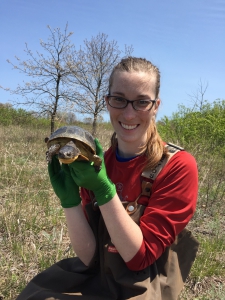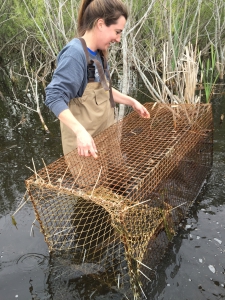Blanding’s Turtle Research
I am excited to be spending my final summer break of veterinary school hiking through forest preserves looking for turtles. As part of Dr. Allender’s Wildlife Epidemiology Lab and along with Dr. Dana Lindemann, the first-year zoo resident at the University of Illinois College of Veterinary Medicine, I am completing a project assessing Blanding’s Turtle wellness.

Erin poses with a Blanding’s turtle
Blanding’s turtles are endangered aquatic turtles found in the marshy waters of the Great Lakes region. They are easily identified by their beautiful yellow necks and spots. They tend to be slightly larger than the Eastern Box Turtles I am used to working with but have a similar temperament, preferring to hide tucked into their shell instead of biting when handled. Their unique name is an honor to the naturalist William Blanding.
I am comfortable working with Eastern Box Turtles thanks to the ‘Turtle Team’, a group of students that assist Dr. Allender with the Box Turtle Wellness Survey each summer. On the Turtle Team, veterinary students and biologists hike through the forest preserves near Champaign-Urbana and, with the help of John Rucker’s turtle dogs, find box turtles. We collect blood, swabs, and measurements to be used in the assessment of box turtle and environmental health.
In order to prepare for my work this Summer, I spent two days with the Turtle Team in Champaign-Urbana perfecting my skills with box turtle sampling and packing the supplies I would need while working in the Chicagoland area. Later in the week I traveled to DuPage and Lake Counties to learn how to trap Blanding’s turtles and begin sampling.

Dr. Lindemann checks a trap for turtles
The traps used to capture turtles are fairly simple and very humane. They are mostly submerged in water and contain bait (usually some type of fish) and a net entry that the turtle cannot go out once it is in. They are checked for turtles every day after they are put out. They are obviously not specific to Blanding’s turtles and ecologists can often find painted turtles, snapping turtles, and crayfish in the traps.
I grew up in DuPage County but I was amazed at the beautiful forest preserves I explored this week. There are so many natural areas that the public never sees because they are off the path and often protected for the safety of the plants and animals living in the habitat. I feel incredibly fortunate that I get to spend my summer walking through these marshes and observing the plants, birds, and turtles living in the area. I am also thankful to the ecologists working for DuPage and Lake Counties that are tireless in their efforts to preserve these habitats and the wellbeing of the wildlife in them. I can already tell that this project is going to be an extraordinary journey and learning experience and I can’t wait to get back out into the field next week!

